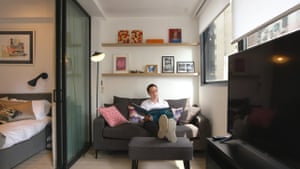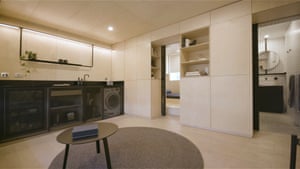It’s hard to explain the exact appeal of Never Too Small. The YouTube series takes viewers on meditative tours of tiny homes from across the world. Yes the spaces are beautiful and the design innovative, but there’s a curdle in the architectural cream. The residences, which range from 22 to 40 square meters in size, are a curious mix of aspirational and off-putting. Part of you wants to live in these dreamy matchboxes, another wonders how anyone could.
Never Too Small began as a pet project for director and design fan Colin Chee, a way to engage with the architects he admired. It only took four episodes to realise he was on to something. With views growing daily, his employer – Melbourne-based production company NewMac – encouraged him to develop the series. Two years later the channel has drawn a huge following, boasting over 700,000 subscribers, with videos regularly bringing in millions of views.
The episodes are as spare and exacting as the designs they celebrate. Chee spends half an hour with the architects – speaking with them and being shown the spaces – then cuts the interviews into clips of five minutes or less. Sometimes it takes him two days to select the perfect piece of background music.
He has featured homes in Australia, Hong Kong and London (with more European profiles in the works). The subjects are largely young inner-city professionals without children. Which hints at Never Too Small’s appeal. There’s a comfort in seeing people managing the mythical task of finding affordable, beautiful homes in central locations. The series suggests maybe you can have the life you want – it just might be on a smaller scale than you imagined.
Chee began the series after moving into a 40 sq m studio in Melbourne’s CBD. Despite growing up in a five-bedroom home in Malaysia, he found micro-living suited his lifestyle and made him feel more connected to the city. “The way I think of it is the supermarket across the street is my pantry,” he laughs. He’s not alone in prioritising location over size. Architect and urban designer Katherine Sundermann reflects that, “There has been a return to the city, a lot of people want to live in urban areas … a way to make that work financially is to live in a much smaller space.”

Money isn’t the only concern. Since many Australians have spent time living overseas in cities like New York and Tokyo, Sundermann observes that by the time they come home they may have discovered smaller apartments “can be a really high-quality experience and a great way to live.” This chimes with Chee. Before downsizing he was already reconsidering his relationships to space and possessions. Like many of us he found himself wanting to own less, consume more thoughtfully and be less controlled by debt.
There’s also a growing focus on the environmental benefits of micro-homes. Smaller-living advocates point out the lifestyle is inherently greener. As Sundermann explains: “The amount of energy and water you’re using (in comparison to living in a larger home) aren’t insignificant. Especially if you have a well-designed new apartment. You might not even need to turn on your heater in winter, compared to living in a detached weatherboard in the suburbs where your energy costs can be very high.”
The homes in Never Too Small are aspirational, but most tiny apartments aren’t a conscious choice of the young, rich and stylish. Scrolling through the comments below Chee’s videos, you quickly realise they rub many the wrong way. Viewers point out that these homes are only available to the wealthy, where many first-homebuyers and young people are more likely to be stuck with poorly designed and overpriced “dog box” apartments.
The majority of Never Too Small’s views are from the US, Germany, UK and Canada, where these designs still feel like a novelty. The channel is notably less popular in Asia. Local commenters on tours of Hong Kong residences don’t deplore the lifestyle choice – they marvel that by their standards these “micro-apartments” are quite large.
Looking to Hong Kong offers a glimpse at the possible future of this trend. There micro-apartments are nothing new; reporting on the increasingly tiny new developments has become something of an observer sport. Recent builds include apartments that are smaller than standard prison cells. Despite the insistence that smaller living is a way for more people to become part of the property market, they’ve done little to impact housing affordability. In 2016 a 19.4 sq m apartment in Pok Fu Lam set a city record for micro-apartments and made international headlines when it sold for over US$1m (AU$1.4m).
Conscious of these realities, Melbourne and Sydney have introduced reforms to dictate minimal dwelling sizes and ensure the liveability of smaller spaces. In 2016, Victorian planning minister Richard Wynne explained the government was “plugging the hole in the planning rules which allowed dog boxes to be built, because we want future apartments to be constructed for long-term living”. The regulations came in the wake of a 2015 report by City of Melbourne planner Leanne Hodyl that detailed how “weak, ineffective or nonexistent” regulation had created an environment where developers went largely unchecked, and apartment building in Melbourne had exceeded maximum densities allowed in Hong Kong, New York and Tokyo.
These conversations exist against a backdrop where many are beginning to interrogate how urban Australian living will evolve in the next few decades. Australian houses are the biggest in the world, but that could change as a building boom transforms our largest cities. Between 2014 and 2015, apartment-building activity in Victoria grew by 22% as the numbers of apartments caught up to the number of houses being built. Melbourne is predicted to become Australia’s largest city by 2037, with the population hitting 8 million. This growth means Melbourne residents may need to get used to living in smaller spaces and build a city that accommodates them.

Chee is optimistic that through regulation, design and city planning, a future populated by micro-apartments needn’t evoke the crowded homes of Hong Kong. In an email after our chat he stresses that, “Instead [of] limiting the apartment size … we should put an emphasis on the design and quality … If we have good-designed dwellings for everyone, it also creates opportunities for a better community.”
Sundermann agrees, although concedes that all housing has drawbacks: “There’s something about living in a detached house in the suburbs that can actually be quite isolating.” She argues there’s a middle ground between sprawling, lonely suburbs and extreme micro-living. This is the “missing middle”.
“At the moment we have the very high towers in the centre with the little one-bedroom apartments, and then we have the suburban three-to-four-bedroom homes. But we’re missing some nice, modest, six-to-seven-storey apartments in well-serviced inner suburbs.” She’s interested in programs that are looking to consolidate existing suburban homes to build moderate new apartments, with a focus on shared gardens and spaces, natural light and a variety of apartment types. She points to more recent developments such as Nightingale Housing and Assemble Communities as examples of how that might work.
While the thought of redesigning our cities, lives and homes is daunting, our exploding population means major changes are inevitable. And if Never Too Small’s ever-growing views are anything to go by, we might be more drawn to a micro-living future than we admit.